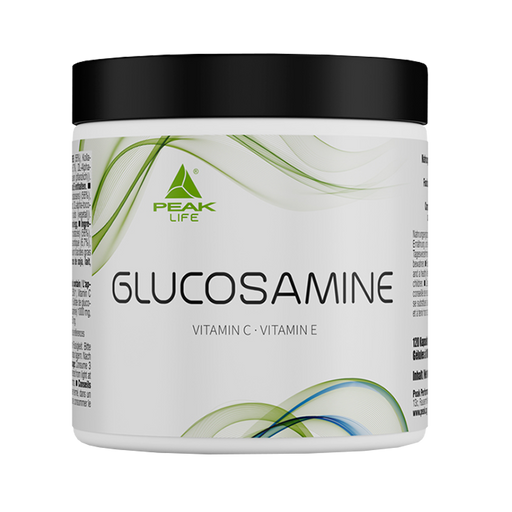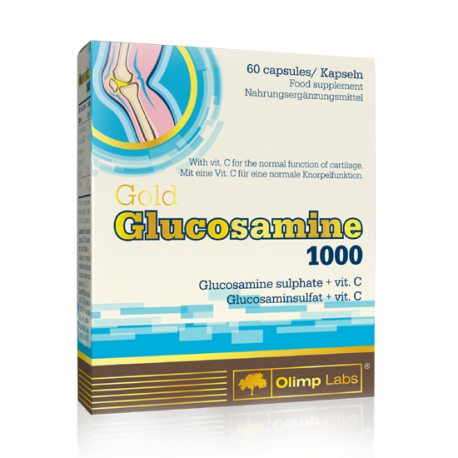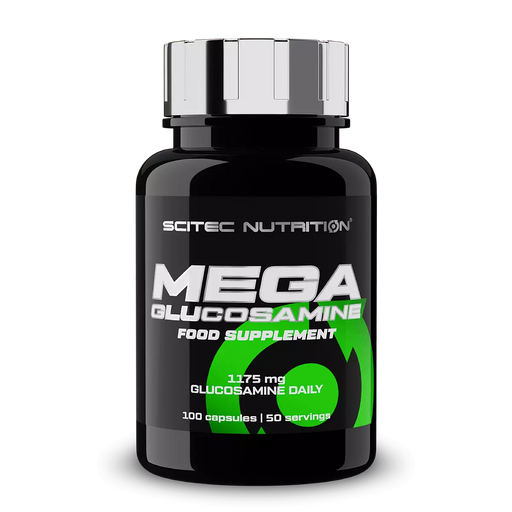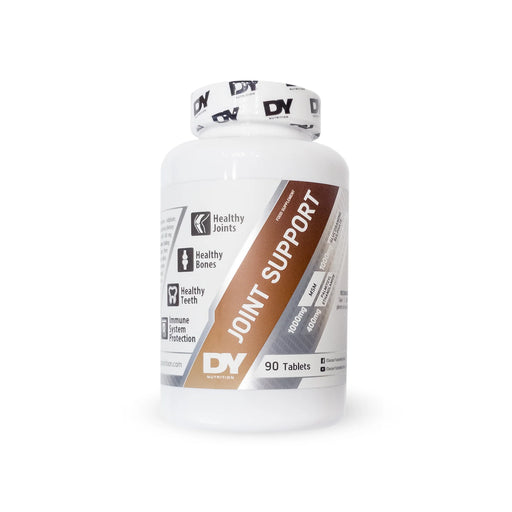Glucosamine
-
 Save 20%
Save %
Original price €39,90Original price €39,90 - Original price €39,90Original price €39,90Current price €31,90€31,90 - €31,90Current price €31,90| /
Save 20%
Save %
Original price €39,90Original price €39,90 - Original price €39,90Original price €39,90Current price €31,90€31,90 - €31,90Current price €31,90| /Bionic Joints · 400g
GN Laboratories29 reviewsJoints, tendons and ligaments are all structures that can be put under a lot of strain through sport. This strain requires that the joints are alwa...
View full detailsOriginal price €39,90Original price €39,90 - Original price €39,90Original price €39,90Current price €31,90€31,90 - €31,90Current price €31,90| /Save 20% Save % -
 Save 11%
Save %
Original price €34,90Original price €34,90 - Original price €34,90Original price €34,90Current price €31,06€31,06 - €31,06Current price €31,06| /
Save 11%
Save %
Original price €34,90Original price €34,90 - Original price €34,90Original price €34,90Current price €31,06€31,06 - €31,06Current price €31,06| /Joint Cissus Complex · 120 capsules
GN Laboratories17 reviewsProbably the most comprehensive and effective combination product to promote joint health and regeneration New enhanced formula - now with standard...
View full detailsOriginal price €34,90Original price €34,90 - Original price €34,90Original price €34,90Current price €31,06€31,06 - €31,06Current price €31,06| /Save 11% Save % -
 Save 0%
Save %
Original price €14,90 - Original price €14,90Original price €14,90€14,90€14,90 - €14,90Current price €14,90| /
Save 0%
Save %
Original price €14,90 - Original price €14,90Original price €14,90€14,90€14,90 - €14,90Current price €14,90| /Glucosamine · 120 capsules
PEAK5 reviewsProvides important components of joints, cartilage, tendons and ligaments 1250 mg glucosamine (sulphate) 650 mg collagen protein High doses of vit...
View full detailsOriginal price €14,90 - Original price €14,90Original price €14,90€14,90€14,90 - €14,90Current price €14,90| /Save 0% Save % -
 Save 0%
Save %
Original price €13,90 - Original price €13,90Original price €13,90€13,90€13,90 - €13,90Current price €13,90| /
Save 0%
Save %
Original price €13,90 - Original price €13,90Original price €13,90€13,90€13,90 - €13,90Current price €13,90| /Gold Glucosamine 1000 · 60 capsules
Olimp Sport Nutrition2 reviewsOLIMP GLUCOSAMINE contains glucosamine sulphate and vitamin C for the proper development of joint cartilage. Glucosamine strengthens the joints, s...
View full detailsOriginal price €13,90 - Original price €13,90Original price €13,90€13,90€13,90 - €13,90Current price €13,90| /Save 0% Save % -
 Save 0%
Save %
Original price €17,90 - Original price €17,90Original price €17,90€17,90€17,90 - €17,90Current price €17,90| /
Save 0%
Save %
Original price €17,90 - Original price €17,90Original price €17,90€17,90€17,90 - €17,90Current price €17,90| /Mega Glucosamine · 100 capsules
SCITEC Nutrition1 reviewMEGA GLUCOSAMINE contains 1000 mg glucosamine sulphate per capsule. Glucosamine is important for joint health and cartilage regeneration. It can b...
View full detailsOriginal price €17,90 - Original price €17,90Original price €17,90€17,90€17,90 - €17,90Current price €17,90| /Save 0% Save % -
 Save 0%
Save %
Original price €24,90 - Original price €24,90Original price €24,90€24,90€24,90 - €24,90Current price €24,90| /
Save 0%
Save %
Original price €24,90 - Original price €24,90Original price €24,90€24,90€24,90 - €24,90Current price €24,90| /Joint Support · 90 tablets
DY Nutrition1 reviewJoint Support DY provides a premium blend of MSM and Glucosamine HCl for healthy bones. Contains a unique combination of vegetarian-friendly, sci...
View full detailsOriginal price €24,90 - Original price €24,90Original price €24,90€24,90€24,90 - €24,90Current price €24,90| /Save 0% Save %
Glucosamine is a naturally occurring compound in the body that is involved in the formation of connective tissue, cartilage including articular cartilage, ligaments and other structures in the body. It also lubricates and strengthens joints, allowing for more fluid movement (1, 2). From a chemical point of view, glucosamine is an amino acid sugar. Crustaceans such as crabs are rich in chitin - a highly resistant material consisting of long glucosamine chains. Food supplement manufacturers use chitin as a raw material for the production of glucosamine supplements. Animal bones and connective tissue are also a useful source of glucosamine (3). Glucosamine is one of the most popular dietary supplements worldwide and many athletes also rely on glucosamine - especially for joint problems.
How does glucosamine work?
The secret of glucosamine lies in its ability to increase the production of compounds that build up connective tissue. For example, glucosamine forms complex molecules such as hyaluronic acid, known as glycosaminoglycans (4, 5). Hyaluronic acid will be familiar to most as an ingredient in skin care products. It maintains the skin's moisture and provides anti-aging benefits for the skin. Since glucosamine stimulates hyaluronic acid production, it is used in cosmetics. Glucosamine also protects joint cartilage by maintaining collagen structures. In addition, it has anti-inflammatory and antioxidant effects in the joints, organs and blood vessels. These effects may help protect the body from a range of chronic diseases (6, 7).
Potential health benefits of glucosamine
Glucosamine has anti-inflammatory effects
Glucosamine is often used as a supplement to treat various inflammatory conditions. Although the effects of glucosamine are not yet fully understood, it appears to reduce inflammation. In an in vitro study, glucosamine showed significant anti-inflammatory effects when applied to cells involved in bone formation (8). Much of the research conducted with glucosamine involves a combination with chondroitin - a substance similar to glucosamine, which is also involved in the body's production and maintenance of articular cartilage.
A study of 200 subjects linked glucosamine supplements to a significant reduction in two specific biomarkers of inflammation: CRP by 28% and PGE by 24%, although these results were not statistically significant (9). The same study observed a statistically significant 36% reduction in these inflammatory markers with chondroitin.
Glucosamine supports joint health
Glucosamine occurs naturally in the body. One of its roles is to support the healthy development of the tissue between the joints (10). Articular cartilage is a white tissue that covers the ends of bones where they meet to form joints. This type of tissue, in combination with synovial fluid, allows the bones to move freely in the joint without pain. Glucosamine helps to form several chemical compounds that are involved in the formation of joint cartilage and synovial fluid. Some studies suggest that supplemented glucosamine can protect joint tissue by preventing the breakdown of articular cartilage. A study of 41 cyclists found that supplementation with up to 3 grams of glucosamine per day reduced collagen breakdown in the knees by 27%, compared to only 8% with a placebo (11).
Another study observed a significant reduction in the ratio of collagen degradation to collagen synthesis in the articular cartilage of soccer players who were treated with 3 grams of glucosamine per day for three months (12). In further studies with professional athletes, glucosamine supplements in a dosage of 1,500 to 3,000 mg were able to prevent the breakdown of joint cartilage for up to 4 months and thus support cartilage regeneration (20). Lower doses in the range of 500 to 1,000 mg also showed the same effect in a study with 75 healthy volunteers (21). These results suggest a joint-protective effect of glucosamine.
Glucosamine could be helpful for osteoarthritis
Osteoarthritis is the most common joint disease. Destruction of the joint cartilage and deformation of the joints cause pain and limit mobility. This condition usually affects larger joints such as the knee and hip. Most of the research looked at the effects of glucosamine on symptoms and progression of knee osteoarthritis. A review of 32 clinical trials found that glucosamine improved symptoms of osteoarthritis such as pain, stiffness and joint function better than a placebo (13). In three studies involving 1,800 patients with knee osteoarthritis, glucosamine - alone or in combination with chondroitin - reduced pain, stiffness and swelling of the joints. In two studies, this combination was as successful as non-steroidal anti-inflammatory drugs such as celecoxib and ibuprofen (14, 15, 16).
Other reviews and meta-analyses produced mixed results. Here, glucosamine reduced joint pain better than a placebo, but was unable to improve joint stiffness and function (17). In two further studies involving 105 patients with osteoarthritis of the temporomandibular joint, glucosamine was better at reducing pain and improving mobility than ibuprofen when used for 3 months (18). In contrast, a shorter, six-week study with 1,200 mg glucosamine had no effect on osteoarthritis of the temporomandibular joint in a study with 59 patients (18).
Glucosamine could be helpful for rheumatoid arthritis
Unlike osteoarthritis, rheumatoid arthritis is an autoimmune disease that leads to inflammation of the joints. It causes joint pain and stiffness and can spread to the whole body. Preliminary research suggests that glucosamine may reduce pain caused by rheumatoid arthritis, although the effects on the actual inflammation were less convincing (22). In a study of 51 patients with rheumatoid arthritis, glucosamine significantly improved symptoms (23), while in another study of 22 patients with the same disease, a combination of glucosamine, chondroitin and quercetin showed no effect (24).
In mice with rheumatoid arthritis, glucosamine in various forms suppressed joint inflammation and improved joint function (35). In rats, a combination of glucosamine and vitamin E was able to prevent oxidative damage and inflammation by increasing the levels of zinc and antioxidants (glutathione and SOD), reducing the levels of inflammatory enzymes and uric acid, and reducing the inflammatory factor NF-kB (26).
Glucosamine could alleviate inflammation of the digestive tract
In a clinical study of 38 patients, glucosamine at a dose of 3 grams for 3 months reduced inflammation in the digestive tract and suppressed the growth of diarrhea-causing Clostridia bacteria (27). A study review highlighted the digestive tract healing potential of glucosamine and a link between digestive tract health and joint problems (28). According to laboratory studies with rats and mice, glucosamine could reduce inflammation of the digestive tract and extend the survival span of animals (29).
Glucosamine could help prevent cancer
In a large observational study of over 75,000 patients, those who supplemented with glucosamine and chondroitin had 2-fold lower rates of lung and colorectal cancer. However, according to the scientists, the reduction in colorectal cancer rates was not significant (30). Another observational study with 2,000 subjects showed significantly lower rates of colorectal cancer among glucosamine and chondroitin users (31). However, a larger study with over 6,000 test subjects was unable to establish a significant link (32). In mice, glucosamine was able to reduce the growth of breast and lung cancer (33). In test tube studies, glucosamine was able to kill certain types of cancer cells, but this does not say much about potential anti-cancer effects in the human body (34).
Glucosamine may have effects on glaucoma
Some early research suggests that glucosamine sulfate may promote eye health by reducing inflammation and having antioxidant effects in the retina (35). However, another study suggests that excessive glucosamine intake may be harmful to patients with glaucoma (36).
Glucosamine could have anti-ageing effects on the skin
Since glucosamine can build up hyaluronic acid and other components of the skin, as well as connective tissue, it could reduce wrinkles and improve the appearance of the skin when added to cosmetic products. In addition, it blocks the formation of the skin pigment melanin and could thereby reduce dark skin spots (37). As part of a study, scientists examined skin samples from 8 women who had taken 250 mg of glucosamine daily for 8 weeks. Glucosamine was able to rejuvenate the skin by stimulating the production of hyaluronic acid and collagen (38). The gucosamine derivative N-acetyl-glucosamine could also help to maintain a youthful appearance of the skin (39).
Safety and side effects of glucosamine
Glucosamine is probably safe and harmless for adults when taken orally as directed. Glucosamine sulfate is potentially safe and safe when injected intramuscularly twice a week for up to 6 weeks or applied to the skin in combination with chondroitin sulfate, shark cartilage and camphor for up to 8 weeks. Glucosamine may cause some mild side effects including nausea, heartburn, diarrhea and constipation. Uncommon side effects include drowsiness, skin reactions and headaches, but these side effects are rare.
Precautions and warnings
Pregnancy and lactation: Not enough is known about the safety of glucosamine during pregnancy and lactation. For this reason, pregnant and breastfeeding women should avoid glucosamine to be on the safe side until more is known.
Asthma: There is one report linking an asthma attack to glucosamine use. It is not known for certain whether glucosamine was the cause of this asthma attack. Until more is known, people who suffer from asthma should be cautious when taking products containing glucosamine.
Diabetes: Some early research suggests that glucosamine may increase blood sugar levels in diabetics. However, more recent and reliable research shows that glucosamine does not appear to affect blood sugar levels in people suffering from type 2 diabetes. Glucosamine appears to be safe and safe for most diabetics, but blood sugar levels should be carefully monitored.
High cholesterol levels: Animal studies suggest that glucosamine may increase cholesterol levels. In contrast, glucosamine does not appear to increase cholesterol levels in humans. However, there is some early research suggesting that glucosamine may increase insulin levels. This could lead to an increase in cholesterol levels. For this reason, people with high cholesterol levels who take glucosamine should carefully monitor their cholesterol levels to be on the safe side.
High blood pressure: Early research suggests that glucosamine may increase insulin levels. This could increase blood pressure. However, more reliable research suggests that glucosamine does not increase blood pressure. For this reason, people with high blood pressure who take glucosamine should carefully monitor their blood pressure to be on the safe side.
Allergy to crustaceans: As some glucosamine products are made from the shells of crabs, lobsters or crayfish, there are concerns that glucosamine products may cause allergic reactions in people who are allergic to crustaceans. However, allergic reactions in people who are allergic to crustaceans are typically caused by the meat of crustaceans and not the shell. There have been no reports of allergic reactions to glucosamine in people who are allergic to shellfish. There is also some information that people who are allergic to shellfish can safely use glucosamine products.
Surgeries: Glucosamine may affect blood sugar levels and there are therefore concerns that glucosamine may interfere with blood sugar control during and after surgery. For this reason, you should stop taking glucosamine two weeks before an operation.
Increased intraocular pressure and glaucoma: In a clinical study, glucosamine increased intraocular pressure, which was particularly the case in older people. An observational study with 17 elderly patients came to the same conclusion.
Liver diseases: Some case reports suggest that glucosamine may aggravate chronic liver diseases. However, these observations could not be confirmed by clinical studies.
Interactions
Glucosamine should not be taken in combination with the following medications:
Anticancer drugs (antimitotic chemotherapy)
Some anti-cancer drugs work by reducing the rate at which cancer cells can divide. Some scientists believe that glucosamine can increase the rate at which tumor cells multiply. Taking glucosamine in combination with some anti-cancer drugs could reduce the effectiveness of these drugs.
Care should be taken when combining glucosamine with the following drugs:
Acetaminophen
There are concerns that taking glucosamine in combination with acetaminophen may interfere with the effects of both substances. However, more information is needed to determine whether this interaction is a major cause for concern.
Diabetes medications
There are concerns that glucosamine may increase blood sugar levels in diabetics. There are also concerns that glucosamine may reduce the effectiveness of diabetes medications. However, scientific research suggests that glucosamine is unlikely to increase blood glucose levels in diabetics. For this reason, glucosamine probably does not interfere with the effect of diabetes medication. To be on the safe side, diabetics taking glucosamine should carefully monitor their blood sugar levels.
Blood thinners
Glucosamine may interact with blood thinners such as warfarin and, in combination with these drugs, may increase bleeding time and increase the risk of bruising.
Glucosamine dosage
The following dosages led to positive results in clinical studies:
- Osteoarthritis and rheumatoid arthritis: 1,500 mg per day for 3+ months
- Regeneration of joint cartilage: 1,500 - 3,000 mg (athletes) or 1,000 mg per day for 4 months
- Regeneration after knee injuries: 1,500 mg daily for one month
- Inflammation of the digestive tract: 3,000 per day for 3 months
Glucosamine supplements
Glucosamine sulphate and glucosamine hydrochloride are the most widely used glucosamine salts, which are taken in the form of capsules or powder in dosages of 500 to 1,500 mg per dose. Other available dosage forms include liquid glucosamine in the form of dissolved glucosamine hydrochloride and glucosamine creams or gels for skin care. Most glucosamine supplements also contain chondroitin and other ingredients such as MSM, hyaluronic acid or turmeric extracts.
Vegan glucosamine, which is made from fermented corn, is available in capsule and powder form. This variant is suitable for vegans and people who suffer from an allergy to seafood and crustaceans. Some capsules also contain NAG or N-acetyl-glucosamine. Although this is closely related to glucosamine, it is a different substance with its own benefits and side effects. Dosage guidelines also vary. Most of the studies reviewed in this article did not use NAG.
What is the best glucosamine supplement?
A study of over 600 patients concluded that glucosamine sulfate was more effective for knee osteoarthritis compared to glucosamine hydrochloride, although both forms showed mixed results (40). Glucosamine sulfate probably owes its benefits to better absorption. The sulfur contained in this form may also help build and protect joint cartilage (41). However, in another clinical trial, sulfate and hydrate were equally effective (42).
The strongest evidence comes from a series of comprehensive reviews in which a specific crystalline form of glucosamine sulfate was superior to other forms (44). However, the fact that a pharmaceutical company holds the patent for this form may indicate a conflict of interest. As for other ingredients, chondroitin and MSM may improve the effects of glucosamine on knee pain and joint regeneration, although there is not enough clinical research to confirm this (44).
Glucosamine for dogs
Glucosamine is also available as chewable tablets, capsules and powder for dogs. These products are said to have the same beneficial effects in aging dogs. As in humans, glucosamine has also been shown to have beneficial effects in dogs, but these mainly relate to mild pain relief. Since most dogs tolerate glucosamine well, its use in dogs with joint pain may be worth a try (45). The dosage used in studies for dogs was in the range of 2,000 mg per day, but may vary with the weight of the animal. Some vets recommend 500 mg per 5 kilograms of body weight. Although there are products marketed explicitly for dogs, products intended for humans can also be used.
Conclusion
Glucosamine provides structure and elasticity to skin, joints and connective tissue. As dogs age, a lack of glucosamine can lead to joint pain and wrinkled skin. Food sources of glucosamine include crustaceans, animal bones, skin and cartilage. Glucosamine is the most popular dietary supplement for joint support. It may relieve pain and improve joint function in mild to moderate osteoarthritis, although evidence is limited.
Cosmetics containing glucosamine can remove dark skin spots and improve the appearance of the skin. Crystalline glucosamine sulfate at a daily dosage of 1,500 mg has shown the best results. Chondroitin and glucosamine may improve the effect, although data is limited. Pregnant women, untreated diabetics, people with elevated intraocular pressure or glaucoma, people taking blood thinners and people who are allergic to seafood or shellfish should avoid glucosamine.
References
- https://www.ncbi.nlm.nih.gov/pubmed/27012765
- https://www.ncbi.nlm.nih.gov/pmc/articles/PMC3941227/
- https://pubchem.ncbi.nlm.nih.gov/compound/D-glucosamine
- https://www.ncbi.nlm.nih.gov/pubmed/17716251
- https://www.ncbi.nlm.nih.gov/pubmed/28581831
- https://www.ncbi.nlm.nih.gov/pmc/articles/PMC4997993/
- https://www.ncbi.nlm.nih.gov/pmc/articles/PMC5077170/
- https://www.ncbi.nlm.nih.gov/pubmed/17270442
- https://www.ncbi.nlm.nih.gov/pubmed/24738579
- https://pubchem.ncbi.nlm.nih.gov/compound/D-glucosamine
- https://www.ncbi.nlm.nih.gov/pubmed/23358550
- https://www.ncbi.nlm.nih.gov/pubmed/19724889
- https://www.ncbi.nlm.nih.gov/pmc/articles/PMC4359794/
- https://www.ncbi.nlm.nih.gov/pmc/articles/PMC4717399/
- https://www.ncbi.nlm.nih.gov/pubmed/9638313
- https://www.ncbi.nlm.nih.gov/pubmed/25085275
- https://www.ncbi.nlm.nih.gov/pmc/articles/PMC6097075/
- https://www.ncbi.nlm.nih.gov/pmc/articles/PMC4076897/
- https://www.ncbi.nlm.nih.gov/pubmed/22001199
- https://www.ncbi.nlm.nih.gov/pubmed/30132529
- https://www.ncbi.nlm.nih.gov/pmc/articles/PMC4997993/
- https://www.mayoclinic.org/drugs-supplements-glucosamine/art-20362874
- https://www.ncbi.nlm.nih.gov/pubmed/16953394
- https://www.ncbi.nlm.nih.gov/pubmed/19202302
- https://www.ncbi.nlm.nih.gov/pubmed/22434264
- https://www.ncbi.nlm.nih.gov/pubmed/30021375
- https://www.ncbi.nlm.nih.gov/pubmed/22821424/
- https://www.ncbi.nlm.nih.gov/pubmed/9824843
- https://www.sciencedirect.com/science/article/pii/S0144861710002614
- https://www.ncbi.nlm.nih.gov/pmc/articles/PMC3175750/
- https://www.ncbi.nlm.nih.gov/pmc/articles/PMC4990485/
- https://www.ncbi.nlm.nih.gov/pmc/articles/PMC5794904/
- https://www.ncbi.nlm.nih.gov/pmc/articles/PMC3901559/
- https://www.ncbi.nlm.nih.gov/pubmed/28922722
- https://www.ncbi.nlm.nih.gov/pubmed/25655796
- https://www.ncbi.nlm.nih.gov/pubmed/23702812
- https://www.ncbi.nlm.nih.gov/pubmed/17716251
- https://www.ncbi.nlm.nih.gov/pubmed/28214837
- https://www.ncbi.nlm.nih.gov/pubmed/19845667
- https://www.ncbi.nlm.nih.gov/pubmed/17658908
- https://www.ncbi.nlm.nih.gov/pubmed/18295513
- https://www.ncbi.nlm.nih.gov/pubmed/16324409
- https://www.ncbi.nlm.nih.gov/pubmed/28332780
- https://www.ncbi.nlm.nih.gov/pubmed/16999714
- https://www.ncbi.nlm.nih.gov/pubmed/20020968






